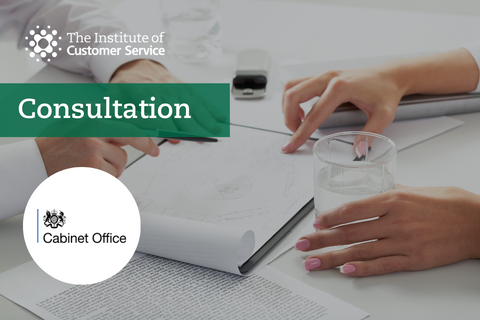The Institute of Customer Service response to the Cabinet Office Consultation ‘A Public Service Ombudsman’
The Institute of Customer Service is an independent not for profit professional membership body. Our purpose is to help organisations strengthen their business performance by improving their customers’ experiences.
Overview
The Institute of Customer Service welcomes the opportunity to comment on this consultation and the future of the public sector Ombudsmen. The public sector faces some difficult challenges including rising customer expectations, rising demand, fragmentation of services and economic austerity. We are encouraged to see the proposals for a new combined Ombudsman as we believe, based on our research, that an aligned approach to the delivery of public services is something that customers require. An integrated approach to complaints is an essential part of this and can help drive improvements in complaint handling throughout the public sector.
The Institute of Customer Service regularly conducts research across all sectors of the economy on customer service issues. We have a wealth a data that provides useful insights into how public sector organisations are performing in comparison to other organisations. In particular, our report Handle with care: An analysis and toolkit to improve complaint handling contains tools for any organisations wishing to improve complaint handling. This report contains an ideal complaints handling process (reproduced in Annex A) that we have developed based on our research into what customers want and the new Ombudsman should incorporate this into its processes.
Our report Citizens and customers: further building the case for customer service in the public sector contains key recommendations for public sector organisations to improve their performance on customer service issues. The new Ombudsman should consider these recommendations. The full set of recommendations has been reproduced in Annex B but key ones the Ombudsman should consider are: provide clear and easy ways for customers to make a complaint using a channel of their choice have a clear definition of what constitutes a complaint against sector and national benchmarks undertake root cause analysis and use it to improve processes and prevent problems occurring how long it will take to resolve the complaint customer and organisation to act with flexibility to respond to customer needs follow up with customers after a complaint to ensure it has been resolved an escalation process for complaints which have not been resolved, which customers are aware of and can access
Key Statistics
Throughout our response we have used data from the UK Customer Satisfaction Index to demonstrate what customers want in relation to complaints in the public sector. The key highlights are: in the last 12 months 19.8% of customers have had a problem when with local public services and 18.4% with national public services. This represents the highest across all sectors except for telecoms. The top two reasons people complain about public services are staff attitudes (local public services: 33.6%; national public services: 34.6%) and staff competence (local public services: 31.4%; national public services: 38.9%).
There are a high proportion of silent sufferers – 35.3% of customers with a problem with local public services did not make a complaint and 33.5% of customers with a problem with national public services did not make a complaint. The principle reason that people suffer in silence is that they do not think that complaining will make a difference (60% for local public services; 56.2% for national public services). Of those that did not complain 13.3% of people for local public services, and 18.9% national public services said they did not know who to complain to. Of those that did not complain 15.7% for local public services and 18.9% for national public services said that the complaints process is ‘too much hassle’.
Across all sectors, public services has the lowest satisfaction levels for the final outcome of a complaint, how it is handled, staff understanding their issue and doing what they say they will, attitude of staff and speed of resolution.
Questions – Principles to underpin reform of ombudsman services
Do you agree that these principles should underpin reform of the Ombudsman service? Citizens We think a more appropriate principle would be ‘Citizens as customers’. The new Ombudsman service should be formed around its customers – the people that complain to the Ombudsman because of the poor service they have received. However, unlike many other services that people use, in the public sector people frequently have no choice in the service they receive. Our research shows that one of the key challenges facing the public sector in improving their customer service is the culture and mind-set of organisations and how to encourage people to be more entrepreneurial and innovative in environments which have traditionally been risk averse and where the incentives to change behaviour are unclear or uncertain.
It will be helpful for both any new Ombudsman service and the bodies that it will oversee to consider those it as serves as customers to help counter this cultural obstacle and, therefore, the terms ‘customers’ as well as ‘citizens’ should be encouraged. We note that the consultation document itself uses this language throughout.
We do think that there is a role for the Ombudsman in providing assurance that public service providers will take action to learn from mistakes. Public services score joint bottom in the UK Customer Service Index for how likely complainants think it is that the organisation will learn from their complaint in order to reduce the likelihood of similar problems for customers in the future.
We also agree that the arrangements should be easily accessible by, and intelligible to, the public. Of those that said they did not complain when they had a problem 13.3% of people for local public services, and 18.9% national public services said they did not know who to complain to. A further 15.7% for local public services and 18.9% for national public services said that the complaints process is too much hassle. There is significant scope for improvement in making the complaints process more accessible.
Parliament
Appropriate accountability mechanisms should be put in place. One way in which a new Ombudsman service could be held to account for its performance is if it was required to publish its own customer service metrics in its annual report to Parliament. This would be a useful model for all public sector bodies.
Value for Money
We appreciate the need for all public services to achieve demonstrable value for money. However, we are concerned about the emphasis on delivering ‘ever greater value for money.’ There needs to be a greater focus on delivering a reliable, high-quality service at a reasonable cost, not just spending less money.
Our research on what customers want across other sectors of the economy shows that 62% of customers want a balance of price and service with at least a minimum threshold standard of service. A further 23% indicate a preference for excellent service, even if it costs more. Just 14% of customers seek the cheapest possible deals and will sacrifice levels of service to achieve them. This should be taken into consideration when the service level provided by any new Ombudsman service is set and an appropriate balance found between the cost of the service and the quality of the service provided.
There is, however, greater scope for collaboration in the public sector and this has the potential to enable more to be delivered with the same resources.
The proposals A new single Public Service Ombudsman (PSO)
Would you welcome the creation of a single Public Service Ombudsman service and are these the right services to be included?
Yes. We support the proposal in principle because a new single Ombudsman would be a simpler, clearer service for those with complaints arising from public services to access.
Research from The Institute of Customer Service shows that 19.8% of customers have had a problem with local public services and 18.4% with national public services (the highest across all sectors except for telecoms). The top two reasons that people complain about public services are staff attitudes (local public services: 33.6%; national public services: 34.6%) and staff competence (local public services: 31.4%; national public services: 38.9%).
However, as noted above in our response to Question 1, many people do not complain because they are unsure to whom they complain or think that it would be too much hassle. There is, therefore, a need to improve the complaints process throughout the public sector and a reformed Ombudsman could contribute to this. As noted above, there is scope for greater collaboration on customer service issues and the new Ombudsman should work to imbed high quality complaints handling process in all the bodies it oversees. We have set out in Annex A what an ideal complaints handling process looks like. Some of the key characteristics are: a clear definition of a complaint; clear and easy ways for customers to make a complaint; training to detect and anticipate complaints; proper analysis and benchmarking of complaints; follow up of complaints; feedback from complainants; and, quick resolution of complaints.
If so, do you agree that these are the right founding principles for such an organisation?
Please see our response to Question 1. We think that the focus should be a delivering a quality service to customers. Our report Citizens and customers: further building the case for customer service in the public sector contains the key recommendations for building a customer focused culture in the public sector (see Recommendation 4 in Annex B) and the new Ombudsman should focus on these areas and encourage the bodies it oversees to do the same. These recommendations are derived from our research in the UK Customer Satisfaction Index which shows the key areas for any organisation to focus on to improve customer service are:
- Professionalism – Staff helpfulness, competence and friendliness, and overall ability to make the customer feel valued
- Quality & efficiency – Ability to deliver a reliable, high-quality service at a reasonable cost
- Ease of doing business – Providing accessible information/ advice and making the overall experience easy for customers
- Problem solving – Handling and resolution of enquiries and complaint
- Timeliness – Speed of service/response and on-time delivery
Should a single public service ombudsman organisation also retain specific sector facing services and staff in eg. Health or Housing?
Yes. An essential part of excellent customer service is professional staff. This includes staff that are helpful, courteous, competent, display emotional intelligence and have the relevant skills and knowledge. The new Ombudsman should develop and measure standards covering professionalism to ensure this (see Recommendation 4.2 in Annex B). Retaining sector specific staff who can be specialists in that sector would be a good step towards ensuring competent staff who can better serve the new service’s customers.
Should each sector within the organisation be led by a senior Ombudsman (or someone of equivalent status) eg a Housing, Local Government or Health Ombudsman?
Yes. Please see our response to Question 4 – the professionalism of staff is a part of the delivery of excellent customer service. Having sector specific leaders and specialisation within the service would contribute to this. Furthermore, our report Citizens and customers: further building the case for customer service in the public sector recommends organisations review their leaderships’ commitment to customer service (see Recommendation 1 in Annex B). The new Ombudsman should ensure customer service is recognised as a central organisational objective amongst its senior leadership team, that there is senior level accountability, and job descriptions have clearly defined customer service objectives.
Is ‘Public Service Ombudsman’ the appropriate title for a new organisation?
Visibility will be an important part of making the service accessible to customers. We think it would be useful to conduct some research into a title that customers would easily recognise and understand. A service accessible to all
Do you agree that there should be the widest possible routes of entry to a Public Service Ombudsman? (i.e. phone, email, in writing)
Yes. Some of the characteristics of good service are ease of doing business, choice and convenience. This means providing accessible information and advice and making the overall experience easy for customers. This is one of the recommendations of our research on customer service in the public sector and a key part of an ideal complaints handling process will provide clear and easy ways for customers to complain using a channel of their choice.
As noted above, the UK Customer Satisfaction Survey shows that of those customers that did not complain when they had a problem with public services, 13.3% for local public services, and 18.9% for national public services said they did not know who to complain to. A further 15.7% for local public services and 18.9% for national public services said that the complaints process is too much hassle. It is clear that improving the accessibility of the complaints processes should be a priority.
Our UK Customer Satisfaction
Survey also shows that simply accepting written complaints would not meet customer expectations. For both local and national public services people preferred to complain face to face (39.5%,37.6%), by telephone (27.0%, 25.1%) or by email (24.2%, 25.3%). Not many people wanted to complain by post (3.6%, 3.8%).
The growing importance of social media must also not be ignored by public sector organisations. Our research shows that of those that communicate with or comment on an organisation 26% do so to make a complaint. The research also reveals, perhaps contrary to popular perceptions, that the use of social media to communicate with or comment on an organisation is spread across age groups. Good service focuses on the needs of all customers rather than taking a generic approach. This type of research demonstrates the need to understand who your customers are and to consider how best to communicate with them.
In what ways could it be made easier for citizens to access resolution and redress?
We think one of the clear problems that customers have in accessing the complaints process in the public sector is a lack desire to complain and a lack of faith that a complaint will make a difference. There are a high proportion of silent sufferers with regards to problems with public services – 35.3% of customers with a problem with local public services did not make a complaint and 33.5% of the customers with a problem with national public services did not make a complaint. Only leisure and transport sectors perform worse (37.1% and 39.6% respectively).
The principle reason that people suffer in silence is that they do not think that complaining will make a difference (60% for local public services; 56.2% for national public services). There needs to be concerted effort to reassure customers that complaints will be taken seriously and to demonstrate the value of complaining. Greater analysis of complaints and better feedback on outcomes could improve this.
An enhanced role for the Ombudsman
Would you support a wider role for a PSO as a champion of effective complaints handling across the public sector?
Yes. As noted above, the majority of those put off from complaining do so out of a lack of confidence that a complaint will make a difference. Public services score worst across all sectors in how likely complainants think is it that the organisation will learn from their complaint in order to reduce the likelihood of similar problems in the future.



Comments (0)